CHAPTER 5: THE TRULY SCALABLE FRAMEWORK
The Three Phases to Profitable,
Seamless, Sustainable Scaling & Growth
KEEP THIS IN MIND.
Mediocre Marketing is inherently disjointed, shortsighted, and rife with tactics, hacks, gaps, and shortcuts that make for poor prospect and customer experiences that the market is now desensitized to. It also puts blinders and handcuffs on founders and teams during strategy and execution that result in futile attempts to solve the wrong problems, confusion as to what to implement and when, and ineffective bandaids on gaping wounds that only fall off in time.
This shortsighted, disjointed ethos is the foundation of the thoughtless, unstable, unreliable approaches to scaling, growth, and fulfillment nearly everyone has all learned, subscribed to, and deployed for years.
Tunnel-vision marketing isn't working the way it used to, when ads costs were much lower, eCommerce brands had healthier margins, and there were fewer ways and paths prospects consumed information about products and brands.
Most marketers, agencies, marketing managers, CMOs, and growth strategists who have subscribed to Mediocre Marketing haven't yet realized their roles and the elements that require their consideration, attention and care need to expand in scope in order to develop the right solutions to the real, deeper problems and successfully grow an eCommerce brand profitably in today's climate.
There's a better, smarter, more sustainable way to scale and grow your eCommerce brand– it's a holistic approach that recalibrates the scaling architecture of your business and empowers you to scale faster, more efficiently, and more profitably, even in climates where it seems like everyone else is pulling back and running for the hills.
Now that you understand the mountain of problems that have been holding your business back, I hope your challenge is more obvious now than ever before.
Your challenge as a founder must be to recalibrate the various models in your business that make up your scaling architecture, so that you can happily scale even in the most unsavory climates and blast through the atmosphere in blue-sky conditions, too.
Like I said, this is what it means to become Truly Scalable.
While plenty of brands you've heard of have taken holistic approaches like this one to build their meteoric rise and utterly dominate in their markets, this isn't really about market domination. That's just the delectable bonus that naturally comes about once you and your teams master this philosophy and practice.
This is about engineering a new way to view, evaluate, manage, scale, and grow your eCommerce brand...one that feels in alignment and on-brand.
This about engineering a repeatable process that eliminates your reliance on Mediocre Marketing and those who subscribe to it...a process that will always serve as your North Star, showing you what to do next, when to do it, and how to know when it's done right– forever.
This is about structuring certainty into your business and eliminating the lack of confidence, hesitation and guesswork.
This is about taking control back and feeling like you're truly in the driver's seat–no matter what the most recent platform, market, algorithm, policy, agency, or economic shenanigans look like.
This is about insulating your brand from the bull. 💩
And becoming Truly Scalable starts with evaluating your business across a series of marketing, operational, and departmental performance indicators that help companies make a beeline towards their biggest opportunities for growth and scaling.
This highly in-depth evaluation is structured so that once it's complete you have crystal clear clarity on:
01
How to lower your marketing and operational costs, trim the fat in your business, and get the most out of the marketing channels that yield the most stability and predictability.
02
How to (profitably) rev the engine on one the most volatile channels around (paid social traffic) to accelerate your growth, increase your market share, and scale, stress-free.
03
Where your biggest opportunities are to architect a system that supports profitable scaling and how to read the health of your business, so you can always find your North Star and know exactly what strategies will work for you, which won't (at least not without some modification in the approach), and what should be implemented when.
Your teams are happy, your customers are happy, and you're happy.
It's the cutting-edge solution to Mediocre Marketing fatigue and wandering lost in the wilderness. A solution that not only yields higher returns on marketing and advertising, but also:
builds in a level of accountability with your teams,
sets benchmarks that make sense for all the facets of your business,
builds compelling, ironclad relationships with your prospects and customers,
creates high profit margins by skyrocketing your conversion rates, clickthrough rates, and profitability all around,
instills more cost-efficiency in the operations of your business,
creates more consistency, stability, and longevity,
and otherwise gives the engine driving your marketing and advertising enough fuel to take your brand exactly where you want to go in record time.
Let's go deeper and get into how this works.
Remember when I basically said your breakthrough lies in first understanding that you can no longer afford to analyze and optimize the facets of your business in a silo?
You have to throw out the window the notion that your marketing, advertising, operations, and fulfillment can continue being considered, analyzed, optimized, or managed, in isolation.
You also have to throw out the window the notion that the various channels that make up your marketing and advertising efforts can continue to be considered, analyzed, optimized, or managed in isolation, too.
Here's why.
Your business is an ecosystem, and nearly all of the elements of that ecosystem impact the efficiency, efficacy, and performance of another– in one way or another. As just a few examples:
Paid social performance is impacted by the quality and points of leverage in email, SMS, social media, fulfillment, customer service, experiential marketing, influencer marketing, and SEO.
Social media performance is impacted by the quality and points of leverage in paid social, influencer marketing, experiential marketing, customer service, and email.
Email performance is impacted by the quality and points of leverage in paid social, experiential marketing, and social media.
Fulfillment and operations (like customer service) is impacted by the purchase volume from all your marketing and advertising channels.
Cashflow and your cash conversion cycle are impacted (in part) by supplier terms and the efficiency of all your marketing and advertising channels.
And operational metrics serve as the glue that holds the whole thing together.
Nearly every element of your business directly or indirectly impacts the effectiveness and efficiency of your acquisition efforts.
THE TRULY SCALABLE FRAMEWORK IS A COMPREHENSIVE, DUAL-ACTION SCALING AND GROWTH PROTOCOL.
Instead of wandering around in the dark, throwing spaghetti at what you hope is a wall, and peering through the dying candlelight to see if anything even stuck...
...we establish your brand's baseline; the most comprehensive diagnostic of its kind ever created, to tell you in 30 minutes or less exactly to what degree (or whether) your business has what it takes to hold up amidst the impending bloodbath that analysts predict is on the horizon.
Sounds like a tall order, I know. Here's how we do it.
The way I see it, the biggest problem plaguing founders and their brands in the space is they expect, and are told, that there's something like a recipe to scaling or a blueprint to growth. There is, but it isn't what you've been led to believe. Here's how this typically goes:
A guru/marketer/coach/consultant tells you you need eggs for this recipe, so you throw in two eggs.
But their course or training never told you how many eggs, whether the eggs should be prepared in some specific way or whether they should be raw....and sometimes they conveniently fail to mention that the eggs you need for their particular recipe are actually black vinegar eggs from the mountains of Tibet or something.
You don't find out until after you've bought the training, after you've entered the mastermind, or after you've hired the agency, that you don't actually have what you need.
So you try to implement the thing anyway, and it doesn't work. And you blame them, and they blame you, making you feel like you've done something wrong.
In reality, they assumed you already had black vinegar eggs from the Tibetan mountains... which is a pretty dense assumption to make.
This is why when it comes to scaling and growth, just as I don't believe in courses, I don't believe in recipes or cookbooks. I believe in models. I believe in formulas. Very specific, very precise, very calculated formulas whose outputs dynamically change based on the inputs of your business.
Precision is everything in building strong growth programs.
And along over 8 years of data science, gathering insights from other agencies, and consulting with, running traffic for, and scaling eCommerce brands in our capacity as consultant, media buyer, or fractional CMO, we've come to find that there's actually a very reliable formula for scaling and growth that structures precision (and therefore certainty) into your business.
There are 126 growth factors that we've identified that impact how scalable a brand (and its paid traffic) is, but for simplicity's sake for this article, everything that determines a brand's True Scalability can be bucketed and distilled down to the following.

This, in a nutshell, is the formula for
TRUE SCALABILITY.
To make sure I don't put you into a quantitative coma, I've provided a super simplified version of this formula. But we'll get into all the nitty gritty of this in future.
This list is by no means exhaustive (we'd be here all week) but to give you a general sense of the themes and topics these buckets are getting at (what we call variables), here are a few for each variable.
Attention + Nurturing = content, audience relationship-building, modern-day loyalty programs, overleveraging or underutilization of nurture channels
Market Resonance = Product resonance, conversion rates, CTR, CPC, shareability / virality, customer satisfaction, ambassadorship
Value = AOV (upsells, bundling, pricing strategy), cohort-specific & time-bound LTV (purchase frequency, MRR), EPC
Cashflow = cash on hand
Costs = CAC, unit economics, operations costs, manufacturing costs (including defects), CPMs,
Cash Conversion Cycle = (manufacturer & supplier terms, vertical integration, volume of inventory compared to how fast the product flies off the shelves, revolving lines of credit)
If you aren't familiar with some of these terms and themes, that's completely okay. We can get into all that later.
Secondly, to arrive at a more concrete sense of the state of these variables within your own business, we've identified quantitative and qualitative benchmarks that all brands that are successfully scaling seem to meet or exceed, based on our research and observations from over $130 million in ads data and countless discussions with brands and agencies across the industry.
FOR EXAMPLE, AS PART OF THE NURTURING VARIABLE:
One of these benchmarks lies in a key metric: your 60-day incremental revenue growth rate. The difference between the first order value and customer value 60 days after their first purchase, this metric gets at the heart of: to what degree are first-time customers coming back to the brand for a repeat purchase over the first 60 days of having become a customer?
Generally this metric is also a good place to start in thinking about the window you have to become profitable against your acquisition costs. Now, granted - not all brands have the infrastructure to allow or withstand waiting 60 days to realize profits.
Funded startups and bootstrapping brands in particular may need to realize returns and profit faster in order to sustain operations, pay off debts, or satisfy investor expectations and therefore need to prioritize strategies and initiatives with quicker returns, even if those wouldn't necessarily yield the highest returns (and they often don’t).
But for those who can reevaluate, optimize, and identify a means to float cash over 60 days, like financing the brand’s purchase orders with financial solutions like Plastiq or Parker, opening up other business lines of credit, or applying for net 30 payment terms on ad spend with Meta…
…they may uncover opportunities to scale acquisition efforts that weren’t available to them before, by allowing for slimmer front-end profitability in favor of maximizing the business’ profitability overall.
But what this benchmark gets to the heart of is short-term retention. As companies spend more on acquisition, the cost per acquisition itself tends to get higher, per customer.
But if more and more of your customers repurchase within that 60-day window from earned media channels, the value of those customers increase faster while your CAC (or customer acquisition cost) stays the same, improving your returns overall and increasing back-end profitability in a way that allows greater tolerance for higher acquisition costs, whenever or if ever they arise, due to forces within and outside of your control. If your brand can get your customer value to increase at least 35% within 60 days of the first purchase, you’re golden in this category.
This is where optimizing core email and SMS flows proves SO invaluable. Building more intention into post-purchase flows and beefing up subscription flows is the name of the game in increasing your 60-day incremental revenue growth rate and accelerating your customer lifetime value overall–especially within the first year.
Post-purchase flows should not be as halfassed as they so often are.
They need to: build excitement for the upcoming delivery, making customers feel like they're part of something meaningful, provide tutorials as to best practices in using the product they've ordered, show them what to expect upon receiving their order and communicate anything they need to know, do, or prepare for in order to enjoy their product to the fullest. Present to them complementary products that can help them achieve their aims better, faster, or in a different way.
Also consider the solicitation of feedback via NPS, a review request, or some other survey. Reviews can prove powerful in boosting on-site conversion rates, and this flow is a good opportunity to continue to build that up.
Any legitimate retention marketer whose focus is truly on short-term and long-term retention will tell you that your post-purchase flows for new customers should be, at minimum, 8 emails. Brands selling consumable products with replenishment cycles of 30 days or longer should consider more. Some brands have flows as long as 45 days out.
Messaging should be different between two main customer segments; new customers require more education and brand indoctrination. Returning customers, however, need more opportunities to provide a review, refer others, get more cross-sell opportunities, and receive more praise, rewards, and acknowledgement for their loyalty.
No matter the flow, every email should add value (which doesn’t always have to be education, by the way), evoke emotion in the reader or ideally – both.
When brands follow this guidance and nail these at a level at or beyond the Power Threshold, they’re able to move the needle dramatically in terms of gaining enough runway to become better able to scale amidst rocky climates or low ROAS on paid traffic.
To find out how to access more examples of what these metrics look like, what their performance benchmarks are, see where your brand stacks up, and discover how to engineer scaling architecture that meets them, read on.
But in a nutshell:
The better a brand meets or exceeds these benchmarks, the more Truly Scalable they are.
And so the first of three phases to this process becomes:
I. Determining Your Brand's True Scalability
To be completely clear: this is not some Candyland, Buzzfeed survey-style quiz that's going to tell you what your eCommerce brand's zodiac sign is or which Beatles member you are. This is an incredibly in-depth assessment that dives into your marketing, operational, and departmental data to uproot the realities of your business and helps us determine exactly which very specific levers your brand needs to be pulling right now in order to become Truly Scalable, get the most revenue possible out of your marketing and advertising efforts across the board, and scale with those efforts, headache-free.
This process draws out your business' unique scaling architecture, a forever foundation that self-evolves to achieve any scaling or growth goal a company sets–for life.
Once this becomes a weapon in your company's arsenal, you'll never have to wring your hands about what to do next or wonder if you're on the right track, ever again. The data will always make you and your teams' next steps clear.
This effectively sets the foundation for you to know exactly what strategies make sense for your business, which ones shouldn't be a priority, and which ones just aren't going to work for you, given your current business data.
No more hemming, no more hawing, no more uncertainty, and no more murkiness.
Just confidence and crystal clear clarity. Now we can move on to:
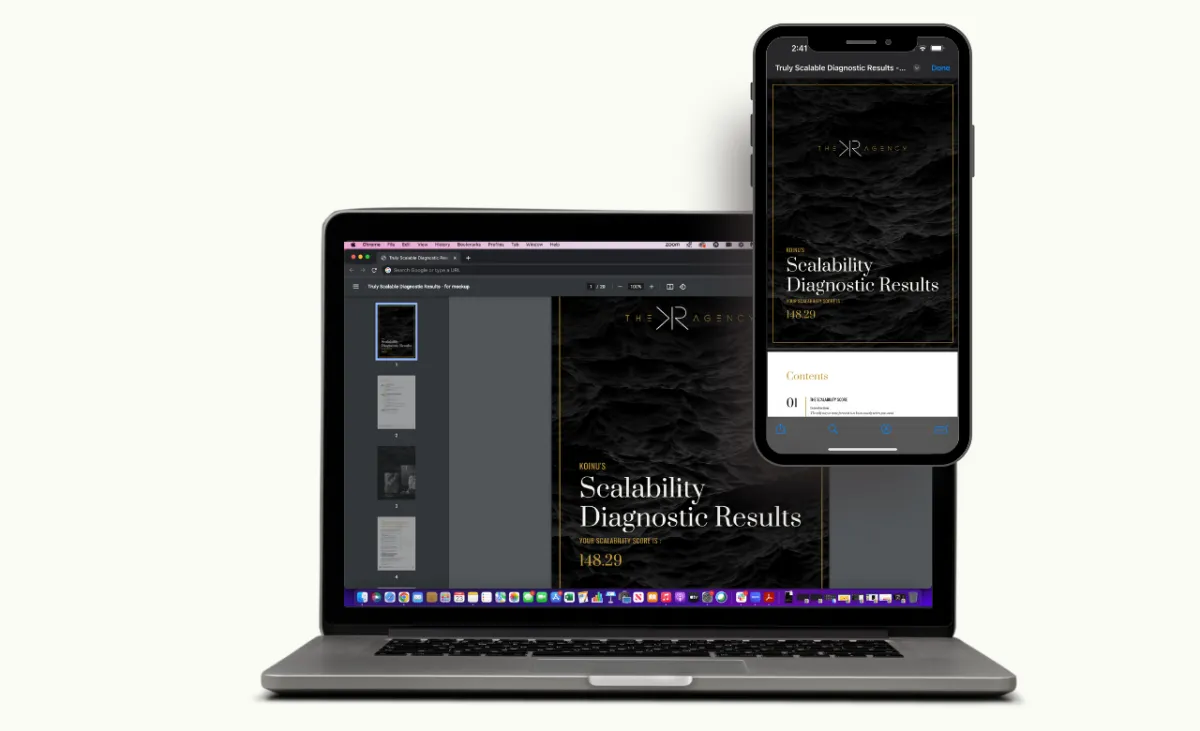
II. Architecting Your Scaling Strategy
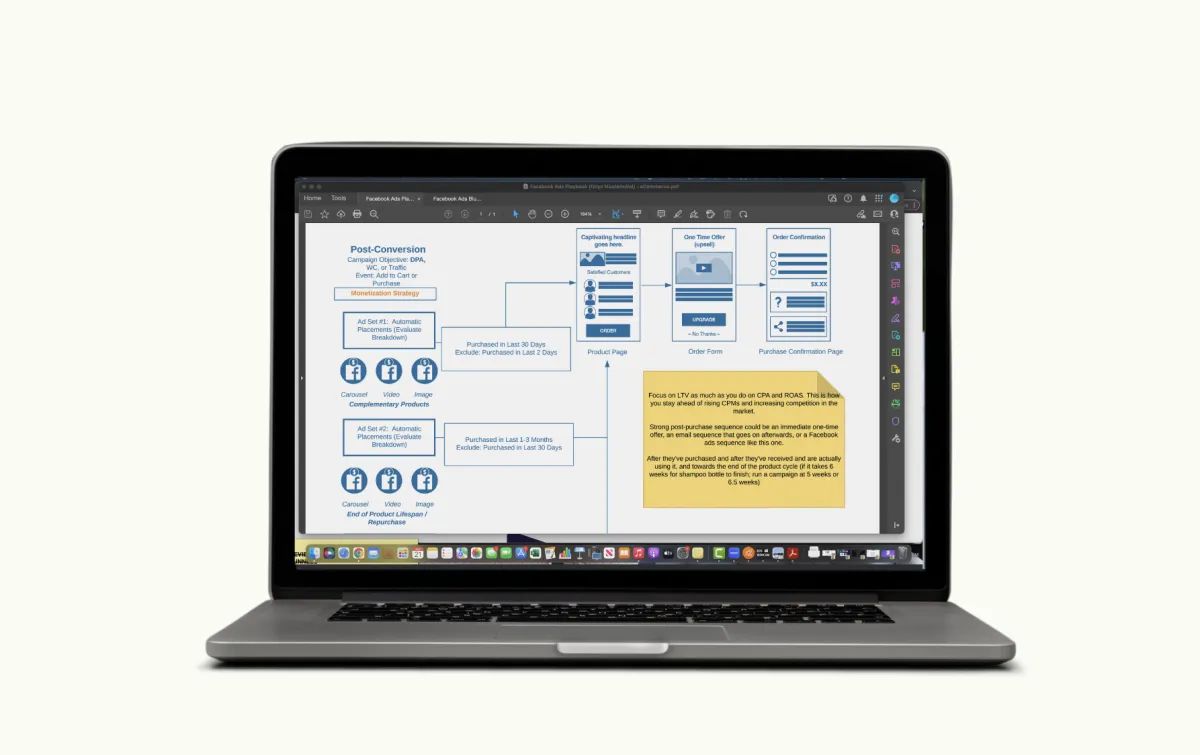
This is where we use this data to determine a concrete plan of attack that will get an eCommerce business in a position to scale much more seamlessly and effectively with paid traffic.
With the guidance of our findings plus additional qualitative data that you provide, we can now map out the brand's collective scaling architecture and determine exactly what strategies, microstrategies, and initiatives across paid social, email/SMS marketing, social media, experiential marketing, influencer marketing and others serve as its biggest opportunities for more profitable scaling and growth.
III. Optimizing And Accelerating Your Paid Traffic Program
Now that a stronger scaling architecture has been established that can actually support flooring the gas pedal on paid traffic and other customer acquisition initiatives, we develop a comprehensive protocol to get the engine that is your paid traffic humming again.
One that puts your business in the driver's seat but upholds the tenets of inclusive marketing by prioritizing all the ways that prospects and customers resonate best, providing authentic experiences, and going with the current (instead of against it) in terms of the various ways each segment of your audiences consume information, resonate with messaging, conjure up obstacles, and make buying decisions.
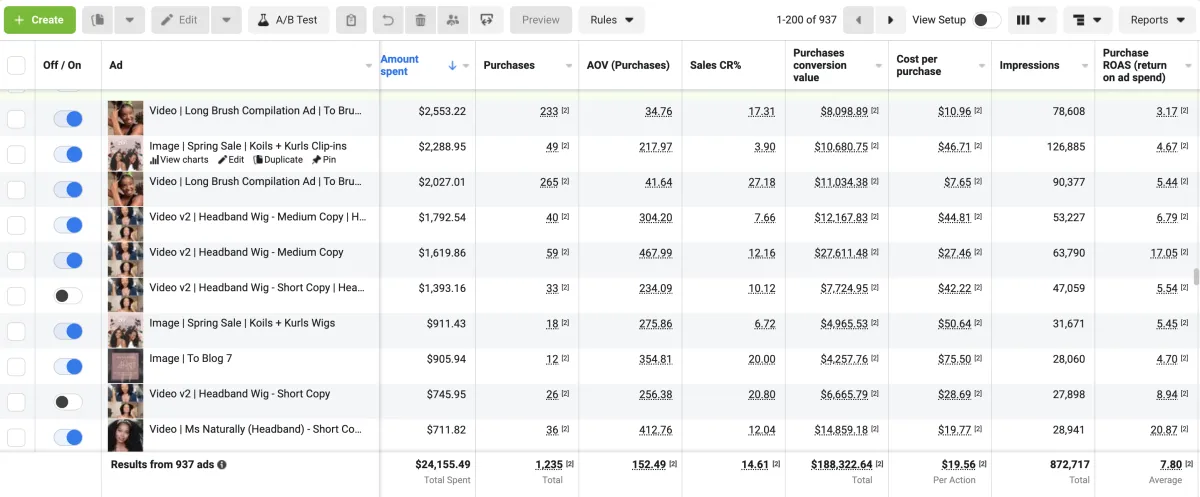
And because you now have a means to structure certainty in your business, the economics of your business are in line, and your brand is showing up in stronger ways that resonate with more of your audience...
...Your conversion rates will be higher, your overall profitability will have improved dramatically, your cost per acquisition will be lower, your channels will run more efficiently and with less redundancy, you can make more decisive calls faster, you'll be better able to hold your marketing teams accountable for their work, and your business will be better equipped to scale even amidst volatile climates, on platforms, channels, and in the market.
The eCommerce Holy Grail.
THESE THREE PHASES ARE THE KEY TO GROWING
AND SCALING PROFITABLY, SEAMLESSLY, AND SUSTAINABLY.
In that order. You can no longer skip a step and expect to yield lasting, consistent results in your business.
In this new climate, brands get tripped up and fall flat on their face when it comes to paid traffic because they're unknowingly skipping steps that no one told them existed.
Virtually all media buyers go straight to Step III, with varying degrees of skill and success (you probably already know how that goes).
Virtually all consultants and coaches go straight to Step II and flutter along the surface, which is why when you get to Step III, things fly off the rails and you struggle.
And nearly all CMOs, marketing managers, and directors of growth try to tackle Step II on a deeper level, but only a level or two deeper and end up missing all the mission-critical nuance that builds certainty, sustainability, and longevity into the business.
The lack of depth that exists in the industry for brands doing under $20 million is truly astonishing given how incredibly margin-sensitive they inherently are. But in a weird, twisted way, it makes sense when you think about what the industry's primary goals are.
And that's to hammer out an ROI, as fast as possible, with as little work and critical thinking as possible, for as much pay as possible.
With the quickness. By any means necessary.
Even if they have to pull out a litany of overused swipe files, templates, and copy-paste messaging rooted in Mediocre Marketing principles.
Even if they have to skip a bunch of steps and take shortcuts, like marketing to only one very specific type of person who consumes information in one very specific type of way, or skipping the process of conducting holistic, current-state analyses across the business to come to smart marketing decisions.
Even if they have to leave every other consideration or lever that's not directly in their proverbial line of sight to an unknown 'someone else'– even when that lever directly impacts their own work, performance, and results.
And all along, no one realizes this is what is actually hurting that collective performance and those results. Mediocre Marketing worked when costs were cheaper, consumers were less discerning and not yet desensitized.
But it's no longer cutting it, now.
So, of course, brands have to pivot.
And the brands who have been employing these practices all along, have not only survived the current climate:
They've thrived.
Because ultimately, they now know what I've been going from room to room trying to tell everyone:
THAT WHEN DATA DRIVES YOUR DECISIONMAKING, YOU CAN BE YOUR OWN GURU.
Now, granted...
...there are great media buyers, CMOs, marketing managers, retention marketers, growth strategists, and consultants in the world who do take some of these steps into account on a deeper level, more than the average person subscribing to Mediocre Marketing.
But only marginally.
For example, in an attempt to scale horizontally, a media buyer may build out ad campaigns with multiple messaging angles and different creative that speaks to the different reasons people buy. They may even do a great job at pulling the levers inside the ad account with the campaigns they've launched.
But their success rate may still be low, because amidst all that lever-pulling and button-pushing, they've also completely ignored the data and insights generated from email marketing, which would have revealed several angles and creative concepts that would skyrocket conversions and make lead costs plummet.
Same goes for the insights from social media. Or SEO. Or brand activations in experiential marketing. Or PR efforts. Or other paid traffic channels. Or customer service logs and tickets. Or content marketing. The list goes on and on.
This is just one example from oodles of instances that reveals how rarely data from other channels is being leveraged, with intention, to build marketing and advertising systems that are responsive to the fluidity and realities of the customer journey and psychology. And that example just is the tip of the iceberg.
We've documented 481 other places in a brand's growth journey where we've seen disjointed marketing like this transpire in companies large and small that, compounded, results in scaling on struggle-mode. Or not scaling at all.
And even if one team member or agency checks all the boxes in all three steps (which we've honestly yet to see on a team of a brand doing under $25 million annually), the other team members, agencies, and marketing stakeholders don't even know these boxes exist.
Nor do the marketing decisionmakers who have been tasked to manage them and hold them accountable. So there's no cohesive game plan. I've seen it time and time again, even inside companies doing multiple eight figures.
Remember, most marketers serving this market are still being held back by the Mediocre Marketing school of thought.
So the marketing and advertising system remains disjointed, clunky, inefficient, and extremely wasteful.
And so you remain unsatisfied with the state of your business and its ability to scale.
Your challenge as a founder is to become able to say YES to these questions:
01
Do you fully understand exactly what’s been preventing your business’ growth and ability to scale and grow seamlessly, predictably, and profitably?
02
Do you know how to identify and deploy the specific levers you need to pull operationally, departmentally, and inside your marketing and advertising programs to achieve, seamless, predictable, profitable scaling and growth–based on data and insights lying dormant across the channels and silos of your business?
03
Do you have a foolproof system of paid traffic sequences, landing pages and funnels that that meet people where they are and reflect the various ways they each resonate, consume information, and make purchase decisions? How much certainty of success do you have when you make decisions inside that system?
This is exactly what The Truly Scalable Framework has been designed to empower you with.
AND THE RESULTS SPEAK FOR THEMSELVES.
One of my consulting clients came to us struggling to get to 2x ROAS, and the business was barely doing $35,000 a month and had shrunk down to just two contractors because the founders couldn't make the numbers make sense. Here's where we got them once we optimized their scaling architecture and revved up traffic again using the Truly Scalable Framework...and they're still scaling up today.
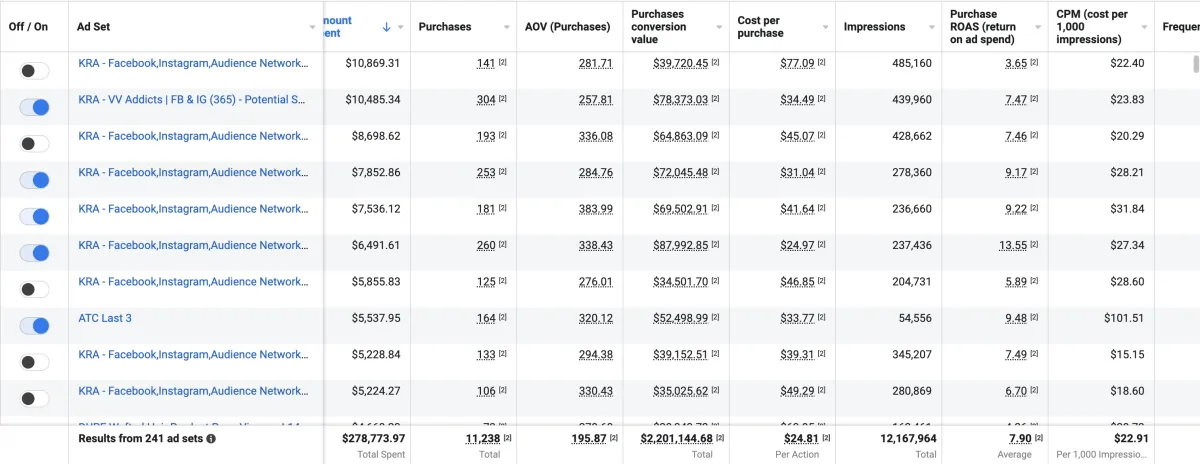
If they could achieve this with a staff of two in their entire company?
Just imagine what you can achieve.
When eCommerce founders implement the Truly Scalable Framework and identify and strengthen their collective scaling architecture, they see results like this across the board:
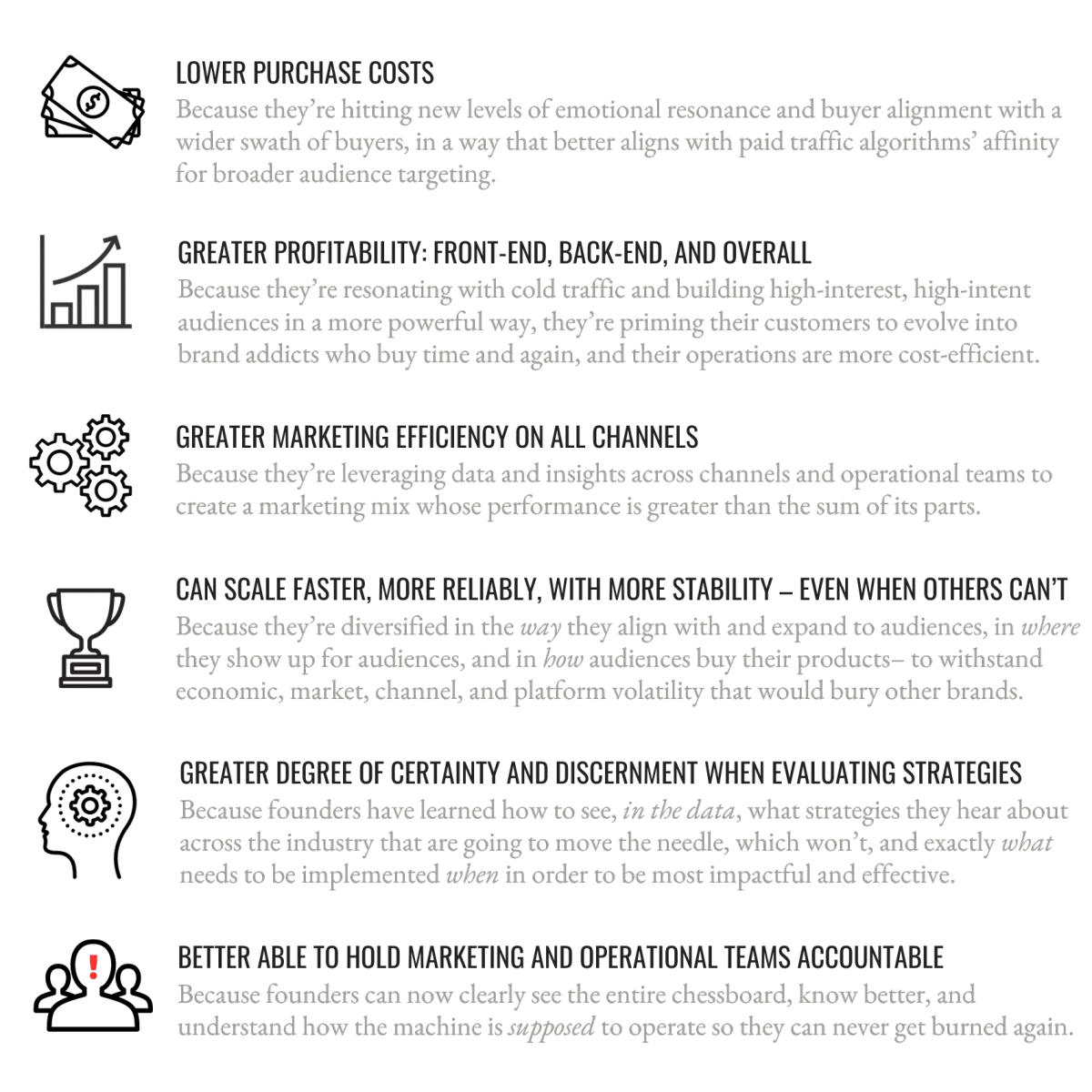
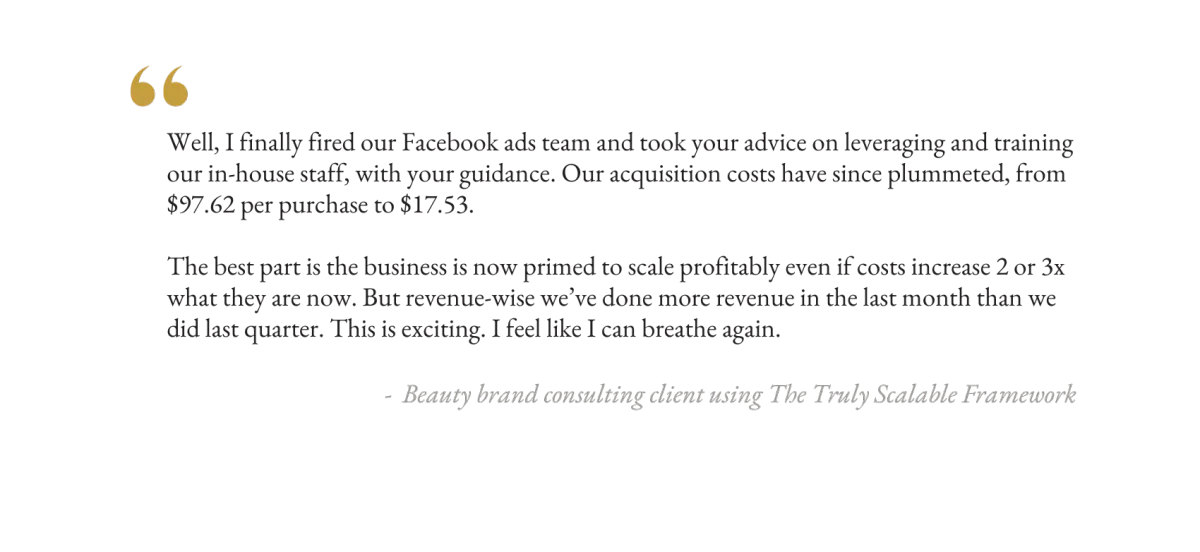
By restructuring your business' scaling architecture to truly support paid traffic and revenue generation that aligns best with your products, audiences, assets at your disposal, and existing marketing mix and data, we can more accurately recalibrate the ways in which you land the first purchase, sell more products per order, and get people buying from you over and over again – while ever expanding your pool of connected and aligned audiences. Compounded, the results are massive.
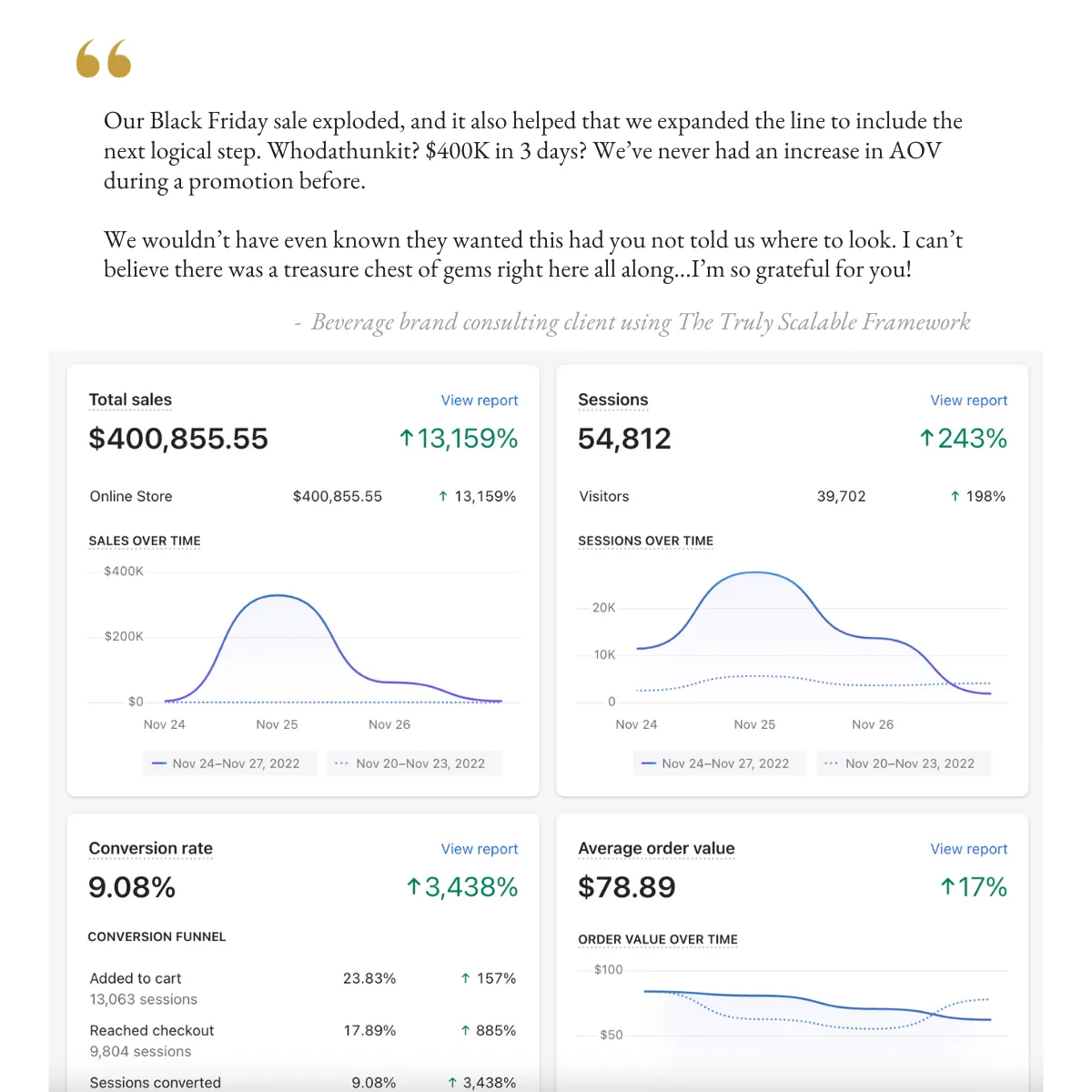
The framework leverages the power of data science, inclusive marketing, and a practice we've coined as holistic media buying (since what we do didn't actually exist in the market) to create a next-level scaling environment that's optimized at every level, on multiple dimensions –operationally, departmentally, and inside each channel of your marketing and advertising mix– all to dramatically improve the efficacy and sustainability of your paid traffic program.
These three phases of the process serve as a guiding light, and the framework is all you'll ever need to get to higher and higher levels of growth because it will always tell you where your biggest opportunities for additional scaling and growth are.
This process allows you to expand your market share, convert at higher rates, gives you the tools to determine how to move next and when, and gets you back into that warm, fuzzy profitability that your CFO and accountant will love.
And...
...it works.
Let's look at the numbers at a macro level, from hundreds of brands.
Across $116.4 million in ads data on Facebook, Instagram, TikTok, and YouTube for companies large and small, across 72 markets that we have consulted and/or run traffic for using this framework:
Their average CPC (Cost Per Click) is $0.46. The average in eCommerce is $1.52.
Their average email sequence conversion rate is 11.2%. The industry standard is 1% to 2%.
ROAS, which we only use to drive a few elements of decisionmaking, is 6.3x on average. The eCommerce industry prays for 2.5 to 3x, on average.
And these figures are at scale, over the course of months to years. Not some flash-in-the-pan snapshot of results that didn't last.
How? Because we're literally architecting companies and marketing ecosystems that seamlessly evolve with changing information, optimize and improve on itself based on the right datasets, and stand the test of time.
A minority of these companies are beholden to VCs, angel investors, and PE funds that rely on consistent, upward-trending, long-term results in order to be able to see returns on their investment.
So they must all be engineered for consistency, longevity and sustainability.
If you're used to Mediocre Marketing, these results sound insane, especially post-iOS 14.5.
But if you look outside of the shortsighted bubble of the internet marketing industry as you know it, you'll come to find these aren't that shocking at all.
It's normal for properly-architected companies to be able to hold their teams accountable and enjoy reasonable acquisition costs, efficient spending, high conversion rates, expanded market share, and peak profitability.
It's normal to pump enough oxygen in the room to breathe so you can scale... when you're not running shortsighted marketing that shuts out the vast majority of people who would be interested in buying what you have to sell, that is...
...or when you're intently paying attention to the nooks and crannies of your business where all the revenue and profit-driving gems lie.
It's normal to have a series of systems and protocols in place that will still allow you to scale in rocky conditions when everyone else around you is flailing and pulling back on ad spend and budgets... while maintaining (or even improving) your profit.
Ready for a new normal?
The Final Page: See If You're Actually Ready for a New Way to Scale
"I know now that those guys don't really know what they're talking about. I know better, so I can do better. You've really opened my eyes and I'm just so glad I found you."
- Bri Muhammad, Founder and CEO of The Beaute Loft
IN A NUTSHELL:
The Truly Scalable Framework allows founders to see the entire chessboard so they can easily discern which strategies will serve them well, which won't, and what to implement when.
If you want a brand that will stand the test of time (and volatility on paid traffic), you need to take a more holistic, connective approach to leading and managing your marketing, advertising, and operational initiatives.
The secret to profitable, predictable, seamless scaling and growth of your eCommerce brand lies in a process designed to build strong scaling architecture into the business that cuts costs, increases revenue, improves cashflow, increases efficiency throughout the business and makes brands impervious to economic, market, channel, and platform forces that typically cause everyone else to grind to a halt.
Psssst, these publications have sought out my insights and expertise.




COPYRIGHT © TRULYSCALABLE.COM | ALL RIGHTS RESERVED | DISCLAIMER | TERMS & CONDITIONS | PRIVACY POLICY